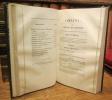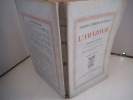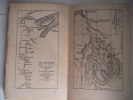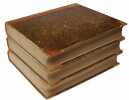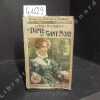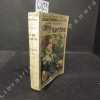-
Type
Book (1034)
Magazine (26)
Maps (3)
Photographs (2)
-
Latest
Last 24h (1)
Last 3 days (1)
Last month (7)
Last week (4)
-
Language
English (2)
French (1063)
-
Century
16th (1)
17th (1)
18th (24)
19th (135)
20th (207)
21st (64)
-
Countries
Belgium (127)
Canada (3)
Denmark (109)
France (746)
Switzerland (80)
-
Syndicate
ALAC (2)
ILAB (251)
NVVA (62)
SLACES (62)
SLAM (77)
PISSARRO - LLYOD, Christopher - Solange Schnall (traduction de l'anglais par)
Reference : 87168
(1981)
Camille PISSARRO (sixième volume de la collection Découverte du XIXème siècle mis en images par Lauro Venturi)
1981 Editions SKIRA. 1981. 1 grand vol in-4. Cartonnage éditeur + jaquette illustrée + coffret carton éditeur. 151 pages. Illustrations en couleur à pleine page hors texte.
Très bon état
La Chine sa religion,ses mœurs,ses missions.
In 12 cartonné rouge à décor passe-partout.Faux-titre, titre,II,149 pages,1 page de table des matières, illustrations en noir hors-texte. Toulouse société des livres religieux 1880.Coiffes réparées.Sinon bon exemplaire
Histoire complète de la découverte de l'Amérique.
relié - 2 tomes en 1 - 10,5x18 - 256 pp et 240 pp - 1938 - éditions CORBET AINE, Paris.
traduite de l'allemand de CAMPE.Nouvelle édition ornée de gravures hors texte.
Théâtre choisi. Précédé dune Introduction par Ch. Nodier, et illustré par des Notices littéraires dues à ses amis, membres de lInstitut, de lAcadémie française, et autres hommes de lettres
Paris et Nancy, Tresse, et Chez Lauteur, 1841
4 volumes in-8 (23,4 x 15 cm), demi-veau marron, dos à cinq nerfs orné de filets dorés, pièces de titre et de tomaison de maroquin vert, tête mouchetée, non rogné (reliure signée Allô). Rare première édition collective, ornée dun portrait de lauteur gravé sur acier par Bosselmann daprès Madame Cheradame, dun plan dépliant de la Bataille de Nancy t. 3 p. 204, et dun plan dépliant t. 4 p. 55. Introduction par Charles Nodier. Notice autobiographique de lauteur « Souvenirs du jeune âge, et détails sur ma vie », Tableau chronologique de ses 120 pièces, Notices par Paul Lacroix, Pujoulx, Elise Voïart, Vaulabelle, Amable Tastu, etc, « Quelques réflexions inédites sur lOpéra comique » par Michel-Jean Sedaine. (frottements sur les dos et les charnières, t. 3 mors inférieur du premier plat fendu). // 4 octavo volumes (23,4 x 15 cm), brown half-calf, spine with gilt fillets, raised on five bands, green morocco labels, top edge speckled, uncut (binding signed Allô). Rare first collective edition, illustrated with a portrait of the author steel-engraved by Bosselmann after Madame Cheradame, a folding plan of Bataille de Nancy vol. 3 p. 204, and a folding plan vol. 4 p. 55. Introduction by Charles Nodier. Autobiographical note by the author « Souvenirs du jeune âge, et détails sur ma vie », chronoogical table of his 120 plays, Notes by Paul Lacroix, Pujoulx, Elise Voïart, Vaulabelle, Amable Tastu, etc, « Quelques réflexions inédites sur lOpéra comique » by Michel-Jean Sedaine. (rubbings on spine and hinges, vol. 3 low join of top cover cracked).
L’Amazonie
in 12 broché, faux-titre, Titre, XIII, 284 pages, 1 page de table des gravures, 15 gravures, hors-texte, 2 cartes. Plon- Nourrit & Cie 1903. Mention de troisième édition
"Quand l'Europe cherchait l'Asie; Jésuites missionnaires (1541-1785). Collection : Eglise vivante."
Tournai (Belgique)/Paris, Castertman, 1954. "15 x 21, 303 pp., quelques illustrations, 1 carte, broché + jaquette, bon état (jaquette défraîchie; cachets du Collège jésuite Saint Stanislas à Mons)."
Quand l'Europe cherchait l'Asie, Jésuites missionnaires (1541-1785). Collection : Eglise vivante.
Tournai (Belgique)/Paris, Castertman, 1954. "15 x 21, 303 pp., quelques illustrations, 1 carte, broché + jaquette, état moyen (jaquette déchirée; cachets du Collège jésuite Saint Stanislas à Mons)."
Ueber die Constitution der elektrischen Spectra der verschiedenen Gase und Dämpfe. (+) Nachtrag zu der Abhandlung über die Consstitution der elektrischen Spectra der verschiedenen Gase und Dämpfe. (2 papers).
Leipzig, Johann Ambrosius Barth, 1859. Without wrappers as issued in ""Annalen der Physik und Chemie. Hrsg.von Poggendorff"", Bd. 107, Viertes Stück.(= Heft No. 8 of 1859). (The entire issue offered (Heft 4 of vol. 107 with titlepage to vol. 107). Pp. 497-660. - Plücker's papers: pp. 497-539 a. 638-643. Clean and fine.
First printing of this milestone paper describing Plückers first observations on Cathode Rays, which he called ""the beautiful and mysterious green glow"", and produced by discharges in tubes exhausted by means of the Geissler pump. These importent observations lead directly to Röntgens discovery of the Röntgen Rays.""Cathode rays were first observed by Julius Plücker in 1859 (the paper offered). They are rays which are found in the neighbourhood of the point of exit of an electrical current passing through a Geissler tube. These rays stimulated intense interest and experiment. William Crookes greatly improved these discharge tubes and intensified the degree of rarification of gases within them. The tubes in this form is known as Crookes tube. Crookes declared his conciction that the cathode rays represented matter in a fourth, hitherto unobserved form....It was reserved for J.J. Thomson (in 1908) to discover the true nature of the cathode rays.""(PMM no 386).
Die Steckelburger der Schweiz. Reise-Eindrücke der Familie Kibs. In Reime gebracht von Carl Plümo, Schullehrer in Staubweiler. 12 Hefte in 6 Bde gebunden.
Basel, C. Schultze, 1864, in-8vo, nach Angaben im Helveticat, (Kat. schweiz. Landesbibl. on-line): ohne die 12 kolorierten Lithogr. die dazugehören, Halbleder d. Zeit, Rückenvergoldung.
Sehr seltene, kaum vollständig auffindbare Reisebeschreibung der Schweiz. 1. & 2. Heft: 277 S. . / 3. & 4. Heft: Zürich. 360 S. / 5. & 6. Heft: Abreise von Zürich. Glarus 362 S.. / 7. & 8. Heft: Ausflug ins Glarner Hochgebirge. 572 S. / 9. & 10. Heft: Bad Stachelberg im Kanton Glarus. 320 S. / 11. & 12. Heft: St. Gallen. 554 S. Wäber -; Image disp.

(SLACES, NVVA)
Phone number : 41 (0)26 3223808
La découverte de l’Amérique par les Vikings. (The lost Discovery). Bibliothèque de la mer.
Paris, Amiot - Dumont, 1954, in-8vo, 252 p., brochure originale avec jaquette

(SLACES, NVVA)
Phone number : 41 (0)26 3223808
"POINCARE, H. (HENRI). - THE DISCOVERY OF AUTOMORPHIC FORMS.
Reference : 49173
(1882)
Sur les fonctions fuchsiennes. (+) Sur les fonctions.... Note. (+) Sur les fonctions.... Note.
(Paris: Gauthier-Villars), 1882. 4to. No wrappers. In: ""Comptes Rendus Hebdomadaires des Seances de l'Academie des Sciences"", Vol 94, No 4 + 15 + 17. Pp. (149-) 184, pp. (997--) 1068 a. pp. (1139-) 1214. (3 entire issues offered). Poincare's papers: pp. 163-168, 1038-1042 a. 1166-67.
First appearance in print of the discovery of the automorphic forms, which Poincaré named Fuchsian functions.""One of Poincaré's first discoveries in mathematics, dating to the 1880s, was automorphic forms. He named them Fuchsian functions, after the mathematician Lazarus Fuchs, because Fuchs was known for being a good teacher and had researched on differential equations and the theory of functions. Poincaré actually developed the concept of these functions as part of his doctoral thesis. Under Poincaré's definition, an automorphic function is one which is analytic in its domain and is invariant under a discrete infinite group of linear fractional transformations. Automorphic functions then generalize both trigonometric and elliptic functions."" (Wikipedia).
Theorie des Groupes fuchsiens (+) Mémoire sur les Fonctions fuchsiennes (+) Sur les Fonctions de deux Variables (+) Mémoire sur les groupes kleinéens (+) Sur les groupes des équations linéaires (+) Mémoire sur les fonctions zétafuchsiennes. - [THE DISCOVERY OF AUTOMORPHIC FUNCTIONS]
Berlin, Stockholm, Paris, F. & G. Beijer, 1882-84. Large4to (272 x 230 mm). Three volumes uniformly bound in contemporary half calf with gilt lettering to spine. In ""Acta Mathematica"", volume 1-5. Light wear to extremities, boards and spines with scratches. Stamp to verso of front board in all volumes. First three leaves in first volume detached, otherwise internally fine and clean. Vol. I, pp. 1-62" Pp. 193-294 Vol. II, pp. 97-113 Vol. III. pp. 49-92 Vol. IV pp. 201-312" Vol. V pp. 209-278.
First publication of these groundbreaking papers which together constitute the discovery of Automorphic Functions. ""Before he was thirty years of age, Poincaré became world famous with his epoch-making discovery of the ""automorphic functions"" of one complex variable (or, as he called them, the ""fuchsian"" and ""kleinean"" functions)."" (DSB).These manuscripts, written between 28 June and 20 December 1880, show in detail how Poincaré exploited a series of insights to arrive at his first major contribution to mathematics: the discovery of the automorphic functions. In particular, the manuscripts corroborate Poincaré's introspective account of this discovery (1908), in which the real key to his discovery is given to be the recognition that the transformations he had used to define Fuchsian functions are identical with those of non-Euclidean geometry. (See Walter, Poincaré, Jules Henri French mathematician and scientist).The idea was to come in an indirect way from the work of his doctoral thesis on differential equations. His results applied only to restricted classes of functions and Poincaré wanted to generalize these results but, as a route towards this, he looked for a class functions where solutions did not exist. This led him to functions he named Fuchsian functions after Lazarus Fuchs but were later named automorphic functions. First editions and first publications of these epochmaking papers representing the discovery of ""automorphic functions"", or as Poincaré himself called them, the ""Fuchsian"" and ""Kleinian"" functions.""By 1884 Poincaré published five major papers on automorphic functions in the first five volumes of the new Acta Mathematica. When the first of these was published in the first volume of the new Acta Mathematica, Kronecker warned the editor, Mittag-Leffler, that this immature and obscure article would kill the journal. Guided by the theory of elliptic functions, Poincarë invented a new class of automorphic functions. This class was obtained by considering the inverse function of the ratio of two linear independent solutions of an equation. Thus this entire class of linear diffrential equations is solved by the use of these new transcendental functions of Poincaré."" (Morris Kline).Poincaré explains how he discovered the Automorphic Functions: ""For fifteen days I strove to prove that there could not be any functions like those I have since called Fuchsian functions, I was then very ignorant" every day I seated myself at my work table, stayed an hour or two, tried a great number of combinations and reached no results. One evening, contrary to my custom, I drank black coffee and could not sleep. Ideas rose in crowds I felt them collide until pairs interlocked, so to speak, making a stable combination. By the next morning I had established the existence of a Class of Fuchsian functions, those which come from hypergeometric series" i had only to write out the results, which took but a few hours...the transformations that I had used to define the Fuchsian functions were identical with those of Non-Euclidean geometry...""
Voyage en Espagne
MAME Alfred et FILS. 1882. In-4In-4 Carré. Cartonnage d'éditeurs. Bon état.Quelques rousseurs. 397 pages. Frontispice en noir et blanc hors-texte. Nombreuses illustrations en noir et blanc dans le texte et en planches hors-texte. Tranches dorées. Relié pleine toile rouge, décorés de motifs noirs et dorés. Illustrations de V. Foulquie
Ray W2*
Le devisement du monde, le livre des merveilles (2 volumes). Collection : La Découverte/Poche/Littérature et voyages.
Paris, La Découverte, 1998. 12 x 19, 2 volumes, 447 pp (pagination continue), broché, très bon état.
"Texte intégral établi par A.-C. Moule et Paul Pelliot; version française de Louis Hambis; introduction et notes de Stéphane Yerasimos."
Le livre des merveilles (traduction, notes et commentaire de Louis Hambis). Collection : Grands textes et civilisations, l'Occident médiéval.
Paris, Club du Livre, Philippe Lebaud, 1977. 29 x 23, 297 pp., gravures sur bois des XIIIe et XIVe siècles, reliure d'édition plein cuir brun à 4 nerfs, plats et dos décorés (noir et or), sous étui carton (ouverture bordée de cuir), tête dorée, parfait état.
"Edition originale, N° 921 sur 2500 exemplaires numérotés sur vélin de Lana; lithographies en couleurs de Stanislas Lepri."
Pommier Patrick Koné Martine Rolando Jean-Michel Collectif
Reference : 500058959
(2011)
ISBN : 9782210521131
Odysséo Découvrir le monde CP-CE1 en 64 enquêtes - Livre de l'élève: Programme 2008
MAGNARD 2011 160 pages 21 8x1 2x28 6cm. 2011. pocket_book. 160 pages.
Bon état
Le Paris Mystérieux. Tome III : La Dame au Gant Noir
sd Editions Arthème Fayard, Collection "Le Livre Populaire" - Sans date (circa 1910) - In-12, broché, couverture illustrée - 382 p.
Bon état - Couverture défraîchie (Plis au dos, frottements, légère mouillure sans atteinte au texte, rousseurs)
Après Freud.
Paris, René Julliard, 1965 ; in-8, broché ; 366 pp. , (1) f.
Exemplaire en très bon état.


Phone number : 06 60 22 21 35
La Logique de la Découverte Scientifique. E=MC2
Payot.1990.In-8 br.Couv.renforcée.480 p.avec Table des Matières.TBE sauf dos insolé.
All under heaven: the chinese world. With text by Jonathan Porter.
New York, Pantheon Books, 1983, in-4to, 190 p., rich. ill. with color plates, orig. cloth, with DJ.

(SLACES, NVVA)
Phone number : 41 (0)26 3223808
Toscane et Rome correspondance d’Italie
in 8 plein cuir glacé vert,fers à la rocaille,en long, filet en encadrement,et titre dorés,au dos.Plaque à froid avec filet doré en encadrement,sur les plats.Filet doré sur coupe.(Ecole Ste Barbe doré sur le premier plat)Faux-titre, frontispice gravé sous serpente,titre,2 pages de table,423 pages, tranches marbrées.Paris Dezobry,E Magdeleine & Cie 1840, bine complet du frontispice qui manque souvent, rousseurs éparses,principalement en début et fin de volume. Un petit frottement sur le premier plat,sans gravité
LE POUVOIR DU MONDE.
, Paris, Editions la Decouverte, 2003., Broche, couverure d' editeur, 13,5x22cm, 259pp.
Quand un journal veut changer la France.
Polyzoa (Bryozoa) - Ascophora - from Norh New Zealand (Discovery Reports Vol. XXXIV)
1 vol. in-4 br., Discovery Reports Vol. XXXIV, Cambridge University Press, 1967, pp. 199-394 avec 17 planches hors texte
Inscribed by the auhor ("Compliment of the author"). Etat très satisfaisant (accroc restauré en coiffes, bon état par ailleurs).
White settlers in the tropics. With additional notes by R. G. Stone. "American geographical society", 23.
New York, American geographical society, 1939,. gr. in-8vo, XII + 311 p. + 88 ill. (photogr. plates), orig. publisher’s illustrated red cloth. Spines sunned, else a fine set.

(SLACES, NVVA)
Phone number : 41 (0)26 3223808
PROUST, (JOSEPH LOUIS) - THE DISCOVERY AND ISOLATION OF GRAPE-SUGAR.
Reference : 45517
(1806)
Memoire sur le Sucre de raisin" (+) Suite du Mémoire....sur le sucre de raisin. (2 Parts).
Paris, Chez Bernard, 1806. No wrappers. Ectracts from ""Annales de Chimie ou Recueil de Mémoires.."" Vol. 57. Pp. 131-174 a. pp. 225-272. With the titlepage to volume 57.
First appearance of a classic paper in which Proust describes his discovery of Grape.Sugar and the identificationof this with glucose. He investigated the varieties of sugar that occur in sweet vegetable juices, distinguishing three kinds, and he showed that the sugar in grapes, of which he announced the existence to his classes at Madrid, is identical with that obtained from honey by the Russian chemist J. T. Lowitz.Proust is famous for his work on the steadiness of composition of chemical compounds.""In chemistry, the law of definite proportions, sometimes called Proust's Law, states that a chemical compound always contains exactly the same proportion of elements by mass. An equivalent statement is the law of constant composition, which states that all samples of a given chemical compound have the same elemental composition. For example, oxygen makes up 8/9 of the mass of any sample of pure water, while hydrogen makes up the remaining 1/9 of the mass. Along with the law of multiple proportions, the law of definite proportions forms the basis of stoichiometry.""(Wikipedia).
 Write to the booksellers
Write to the booksellers

